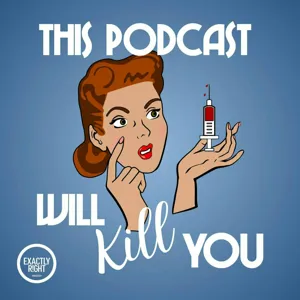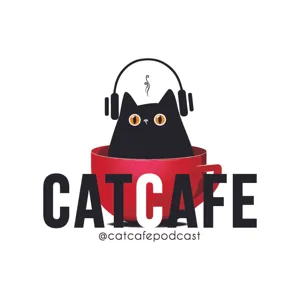Podcast Summary
Working in a Veterinary Clinic During the COVID-19 Pandemic: Challenges and Emotional Toll: Veterinary staff face emotional, physical, and financial challenges during the pandemic, providing essential care for animals while dealing with client frustration and their own exhaustion.
The COVID-19 pandemic has significantly impacted the veterinary field, adding unprecedented stress and challenges for veterinary professionals. Mirica, a veterinary assistant from Vancouver, BC, Canada, shared her personal experiences of working in a veterinary clinic during the pandemic. She highlighted the emotional toll of witnessing animal suffering and dealing with frustrated clients, as well as the physical and mental exhaustion caused by long hours and heavy workloads. The pandemic has also brought financial pressures, with veterinary clinics being the busiest they've ever been and many unable to accept new clients due to capacity constraints. Despite the challenges, it's important to remember that veterinary staff are dedicated professionals who deserve respect and dignity. They are working tirelessly to care for animals and provide essential services, often under difficult circumstances. Let's be kind and understanding towards them during these trying times.
Unexpected consequences of the pandemic in horticulture: The pandemic led to increased demand for plants, long working hours, mental and physical challenges, and continued difficulties despite vaccine rollouts. Nature and human connection became more valued.
The COVID-19 pandemic brought about unexpected consequences in various industries, including horticulture. Sarah, a grower supervisor, shared her experience of how the lockdown led to a surge in demand for plants and long working hours to meet the increased orders. On a personal level, she described the mental and physical challenges of working during a lockdown and the importance of social interactions. The vaccines' arrival brought relief and hope for a return to normalcy, but challenges persisted, such as cancelled weddings and difficulty obtaining PPE. Sarah also highlighted the potential for horticulture to be recognized as a more valued profession following the pandemic. Overall, the pandemic highlighted the importance of nature and human connection during challenging times.
Identification of SARS CoV-2 in Wuhan, China in late 2019: Rapid identification and response to potential pandemics is crucial. The Wildlife Conservation Society plays a role in understanding zoonotic disease origins.
The spillover of SARS CoV-2 into humans from an animal reservoir likely occurred in Wuhan, China, towards the end of 2019. The identification of the causative agent and its sequence was made available to the public within just a few weeks, which is an unusually short time frame for such an event. According to the WHO report, there is little evidence of significant circulation or clinical disease before November 2019. However, by the end of the year, the virus and associated clinical disease were circulating in the community within Wuhan, leading to an increase in mortality and clinical events in the province within a few weeks. This timeline underscores the importance of rapid identification and response to potential pandemics and the role of organizations like the Wildlife Conservation Society in understanding the origins of zoonotic diseases.
Scientists warned of pandemic likelihood, but communication was inadequate: Despite scientists' warnings, inadequate communication led to insufficient pandemic preparation. Prioritize research and communication for future crises.
The COVID-19 pandemic was not an unexpected event, as scientists had long warned of the likelihood of a pandemic. However, the communication of this information to policymakers and decision-makers was inadequate, leading to insufficient preparation. The Huanan Seafood Wholesale Market in Wuhan, China, was a significant contributor to the early outbreak, with many of the first reported cases linked to it. The market sold live wildlife species, which had been linked to previous outbreaks like SARS. However, it is still unclear how the virus spilled over from animals to humans at the market or if there was an intermediary host. The lack of investment in long-term planning and understanding the potential impacts of global events on a large scale, such as pandemics and climate change, is a recurring issue. It is essential to prioritize and invest in research and communication to better prepare for potential crises.
The Interconnectedness of the World During the COVID-19 Pandemic: The COVID-19 pandemic underscored the importance of global responses to crises, as interconnectedness led to rapid virus spread and economic consequences. Significant biomedical advancements, like mRNA vaccines, emerged, and the pandemic highlighted the impact of environmental destruction on global health.
The COVID-19 pandemic highlighted the interconnectedness of the world in ways we never imagined, both in terms of the virus's rapid global spread and the economic consequences. We underestimated the impact of our global economic interdependencies. However, despite mistakes and missed opportunities, significant biomedical advancements have emerged, such as the rapid development and deployment of mRNA vaccines, which will benefit us beyond this pandemic. The pandemic also underscored the reality that environmental destruction anywhere can harm people everywhere. Looking back, a pandemic like COVID-19 in 2003 might have played out differently due to the increased global travel and the faster identification of the virus's origins and sequence. While the therapeutic advancements may not be drastically different, the availability of a vaccine within a year is a remarkable achievement. Overall, the pandemic has provided a stark reminder of the interconnectedness of our world and the need for swift and effective global responses to crises.
The complex issue of wildlife consumption for human purposes: While wildlife markets pose a risk for virus exchange, wildlife meat is essential for nutritional needs in certain regions. Balancing conservation and community access is key.
The issue of wildlife consumption for human purposes is complex and nuanced. While large-scale commercial wildlife markets in Southeast Asia and China sell wildlife as a luxury item and a status symbol, leading to a dangerous interface for virus exchange due to the animals being sold alive, in contrast, wildlife meat is a critical source of protein and micronutrients for millions of people in Central Africa and other regions, where it is essential for their nutritional needs. The commercial trade of wildlife for consumption can deprive these communities of this vital resource. The Wildlife Conservation Society focuses on curbing wildlife trade in urban commercial markets while supporting indigenous peoples and local communities' access to wildlife meat. The biggest risk comes from the live wildlife trade, as the prevalence of specific pathogens increases as the animal moves along the trade value chain. Understanding these dynamics in different contexts is crucial for addressing this complex issue.
Wildlife, forests, and markets interconnectedness in zoonotic diseases: Recognizing and preventing spillover events at interfaces, such as roads, markets, and agroindustrial expansion, is crucial in pandemic control. Collaboration across different sectors is vital in addressing these issues effectively.
The interconnectedness of wildlife, forests, and markets plays a significant role in the occurrence and potential spread of zoonotic diseases, which can lead to epidemics and pandemics. The discussion emphasized that wildlife in their natural habitats act as reservoirs for thousands of viruses, but the creation of interfaces, such as roads, markets, and agroindustrial expansion, increases the chances of spillover events. These events are common but usually harmless, but the more opportunities created at these interfaces, the higher the likelihood that a virus can successfully replicate in human cells and transmit from person to person. Therefore, preventing spillover events and minimizing the creation of interfaces is crucial in pandemic control. Additionally, it's essential to recognize that epidemic and pandemic preparedness and response are distinct aspects, and collaboration across different sectors, such as wildlife conservation, public health, and agriculture, is vital in addressing these issues effectively.
Protecting natural habitats and promoting early detection are key to preventing pandemics: Preserving intact forests and landscapes, early detection and diagnosis, and addressing siloed decision-making processes are essential for preventing pandemics
Effective prevention of pandemics involves a multi-faceted approach that includes protecting natural habitats, monitoring for early signs of disease outbreaks, and improving cross-sector communication and collaboration. The Wildlife Conservation Society (WCS) emphasizes the importance of preserving intact forests and landscapes to prevent spillover events, which are most likely to occur at the edges of disturbed areas. WCS also focuses on early detection and diagnosis using conservation tools and community health centers, paired with innovative technology. However, a significant challenge is ensuring that this information reaches existing public health networks. Another concern is the siloed structure of governments and decision-making processes, which necessitates a "one health" approach that recognizes the interconnectedness of human, animal, plant, and environmental health. As we prepare for future pandemics, addressing these issues will be crucial.
Understanding the origins and spread of pandemics: Recognizing potential public health concerns, characterizing new pathogens, and addressing the root causes of zoonotic diseases require a humble and respectful approach to the planet.
The origins of pandemics, such as SARS-CoV-2, are complex and often involve zoonotic spillover from animals to humans, but the subsequent evolution and spread can occur primarily in human populations. Recognizing which viruses may become a public health concern is a challenging process, and quickly characterizing and disseminating information about these pathogens to inform policy and decision-makers is crucial. The pandemic has highlighted the need for a more respectful and humble approach to the planet, as we face multiple crises, including biodiversity loss, climate change, and global inequities. The rapid emergence of SARS-CoV-2 in late 2019 underscores the importance of understanding the role of wildlife markets in the emergence of zoonotic diseases. Despite our advances in understanding the cell entry and replication of viruses in human cells, translating this knowledge into effective policy and decision-making remains a significant challenge. Overall, the pandemic has provided an opportunity to learn from past mistakes and make the world a better place.
Recognizing the interconnectedness of animal, human, and environmental health: The COVID-19 pandemic underscores the need for a holistic 'one health' approach, acknowledging the interconnectedness of animal, human, and environmental health, and the importance of conservation efforts in reducing the risk of future pandemics.
Effective pandemic preparedness requires a holistic, interconnected approach. Scientific advancements and communication between various sectors and disciplines are crucial, but so is recognizing the interconnectedness of animal, human, and environmental health. The COVID-19 pandemic has highlighted the importance of a "one health" approach, which acknowledges that the health of animals, humans, and the environment are all intertwined. Additionally, conservation efforts are essential in reducing the potential for pathogens to spill over and cause pandemics or epidemics. Despite the challenges in getting different sectors to work together, there is progress being made towards a more integrated approach to pandemic prevention. The pandemic has brought about a broader realization of the importance of this approach for the future.
Reducing human-wildlife contacts through conservation is crucial for preventing future zoonotic disease outbreaks.: Conserving forests decreases human-wildlife contacts, preserves habitat for wildlife populations, and can serve as a food source for local communities, thereby reducing the risk of zoonotic disease outbreaks.
As we continue to increase the interfaces between wildlife, their habitats, and humans, we're increasing the risk of zoonotic diseases, such as the current pandemic. This risk is amplified in large-scale commercial wildlife markets, where many potential contacts occur. Conserving forests, on the other hand, decreases these contacts and preserves habitat for wildlife populations, which can serve as a food source for local communities. Dr. Walzer emphasized that this pandemic is just one symptom of a larger issue, and conservation must be part of the solution. In summary, reducing human-wildlife contacts through conservation efforts is crucial for preventing future zoonotic disease outbreaks. Thank you to Dr. Walzer, Nat, and all those who shared their stories for this episode. Stay tuned for the next episodes in this series, and remember to wash your hands.



